The EAC’s “Clearie” Winners Demonstrate Election Innovation
This story was featured in our ELECTricity newsletter in December 2017. Sign up to receive more success stories from election offices across the country. And how is your election office using technology to run excellent elections? Tell us about it by emailing [email protected] — we’d love to share your story!
In November, the Election Assistance Commission announced the recipients of its Clearie (think “Clearinghouse”) awards for best practices in election administration.
According to EAC Chairman Matthew Masterson, the Clearies serve a dual function: they give recognition for work well done while also amplifying smart ideas for the benefit of other election officials.
“In our work we see first-hand the innovative strategies and unique approaches that election administrators bring to their work,” explains Matt, “and we are always looking for ways to share that information with other jurisdictions that may find it useful.”
In that same spirit, we’re taking a closer look at these 8 award-winning ideas and the people behind them. We’ll also share insights from several of the recipients on the current state of election innovation.
Port Huron Township, Michigan enhances poll worker training through color-coded materials and hands-on instruction
With a population under 9,000, Port Huron Township is the smallest election authority to win a Clearie. But size didn’t stop Clerk Benita Davis and her colleagues from overhauling their poll worker training protocol with new color coding and a “multi-station, hands-on approach.”
The result has been more smoothly functioning polling places at little or no additional cost.
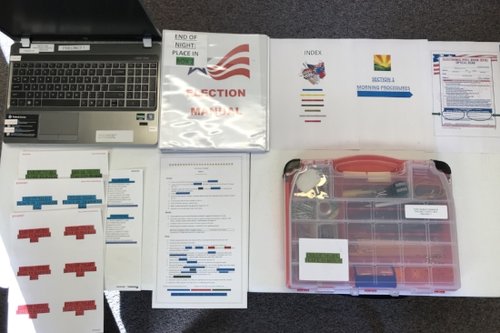
A lot of the inspiration for the new system, Benita says, came out of meetings with organizations like the Michigan Association of Municipal Clerks and the Michigan Township Association.
“I feel that the reason we are able to be recognized right alongside larger authorities is due to the amazing Clerk organizations that we belong to,” she explains, adding, “We’re also fortunate that our workers are so receptive and eager to embrace new things.”
Washington Secretary of State partners with stakeholders to design an accessible web portal
Discussions about accessibility often focus on the idea of compliance. When the Washington Secretary of State decided to rework its MyVote web portal in 2016, however, the state’s Disability Advisory Committee wanted to do more.
They ended up undertaking a full website redesign, working with the Washington Talking Book and Braille Library and the National Federation of the Blind for essential feedback.
“Under Secretary Wyman’s leadership, accessibility is incorporated into everything we do,” says Director of Elections Lori Augino. “Most election officials shy away from major projects in high-stakes years. But this one was so important to the team that they took it on and really delivered.”
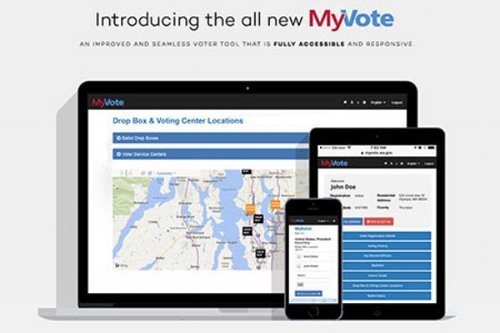
Ultimately, the redesigned MyVote site broke records for voter registrations submitted through the portal, and the Secretary’s office received praise from accessibility advocates.
Indian River County, Florida puts voter education in everyday places with bollard signs
You might not know the word “bollard,” but you’ve definitely seen them. They’re the protective posts that help keep pedestrians safe from traffic in places like big-box stores and public schools. In Indian River County, they also provide voter information.
After seeing bollards used for advertising, the staff of the Indian River County Supervisor of Elections decided to use bollard covers to provide civic information in their community.
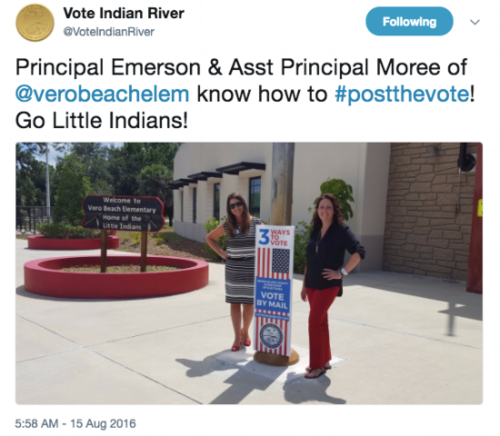
Using the bollard covers, the office has been able to introduce voter education into people’s everyday routines, even Tweeting about it with the hashtag #PostTheVote.
El Paso County, Colorado makes voting more accessible by partnering with a local nonprofit
In 2016, the El Paso County Elections Department wanted to make voting more accessible to people with disabilities, and for support, the staff worked with a community organization called the Independence Center. Combining expertise in elections and accessibility, they worked together to find new approaches to meeting community needs.
Independence Center staff helped train poll workers to better support people with disabilities, and the Department held an open house at the Center to demonstrate voting equipment. The Elections Department even decided to use the Independence Center’s headquarters in Colorado Springs as a vote center location.
All told, the partnership produced better training for the elections team and improved service for El Paso County voters.
Denver, Colorado simplifies the petition signature process with eSign
Clipboards and ballpoint pens might be going out of fashion in Denver. With eSign, the Elections Division’s new mobile petition signing application, people circulating petitions can collect signatures with a stylus and tablet.
Since eSign interfaces with Denver’s voter database, petitioners can immediately confirm if signers are registered to vote and live in the appropriate district. What’s more, signature acceptance rates are far higher than with paper — 97% compared to just 70%.
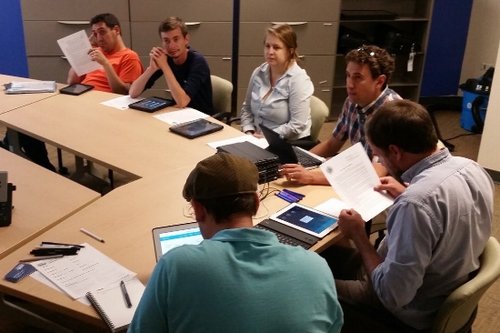
Director of Elections Amber McReynolds stresses that eSign helps the entire community — not just folks circulating petitions.
“By enhancing the ballot access experience,” she says, “we were able to simultaneously increase our operational efficiencies for petition processing (which in turn conserves taxpayer dollars), provide better accessibility options and security to voters signing petitions, and provide improved transparency to candidates and campaigns accessing the ballot.”
Minneapolis, Minnesota helps high schoolers develop civic literacy as Student Election Judges
You need to be at least 18 to vote in Minnesota, but that doesn’t mean you can’t get involved with elections before then. Through Minneapolis’s Student Election Judge program, students over 16 can serve as poll workers, allowing them to participate in the civic life of their city while also earning money or, if they prefer, community service credit.
In turn, the students supply Minneapolis’s Elections and Voter Services Division with needed service — especially regarding language support. In 2016, EVS reported that 45% of Student Election Judges were bilingual.
For more evidence of the program’s impact, you can look at participants’ survey responses. After supporting the 2016 General Election, 91% of students who responded said they now know how to vote, and 85% said they’re more likely to vote as a result of their experience.
Pierce County, Washington streamlines ballot processing using Batch Tracker Manager program
Sometimes, one change can spur more innovation. That’s what happened when the Pierce County Auditor’s Office debuted a digital ballot scan system following the 2016 Presidential Election.
This advance allowed the county’s ballot processing team to handle more ballots more quickly, leading to new innovation: the Batch Tracker Manager. With the BTM, the staff can process ballots in batches of 250, and each batch has a barcoded card for easy tracking through the system.
The result has been greatly improved efficiency.
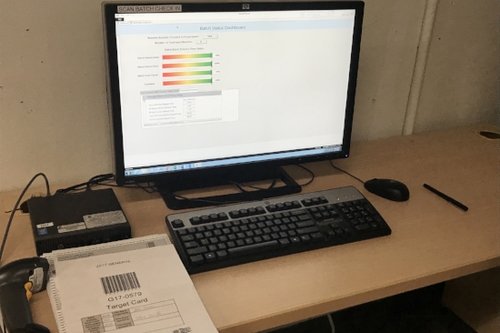
“Implementing new election technology is the best time to unleash creativity!” emphasizes Auditor Julie Anderson. “While you are learning about your new equipment or system, take the time to completely rethink everything in your election workflow. You’ll make surprising discoveries.”
Disability rights organization provides an app to support accessible vote centers in Collin County, Texas
In suburban Dallas, a local accessibility advocacy group partnered with the Collin County Elections Department and other groups to help make vote centers more accessible.
Kate Garrison, President of Collin County Democrats with Disabilities (CCDWD), wanted to make a mobile app that members of the public could use to assess polling place accessibility and report problems. Using Google Forms, Kate made a simple program prompting volunteers to check for proper signage and curbside voting space.
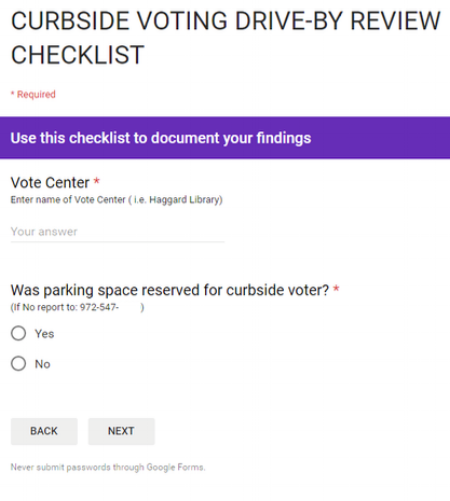
“The app,” explains Kate, “enables the system administrator to respond to requests to vote without entering the polling place (curbside vote) in a more consistent way. Now, the voter no longer has to honk the car horn or ask a pedestrian to notify the polling place judge.”
During the 2016 General Election, volunteers used the app to to review 45 vote centers, and they reported 17 locations with signage problems and 15 that lacked space for curbside voting. Working with Elections Administrator Bruce Sherbet, CCDWD made recommendations to resolve problems for future elections.
The Clearies as a group
The Clearie winners are a diverse bunch, including election offices large and small, from coast to coast.
Matt Masterson says he was pleased — but not surprised — to see so much variety among the submissions.
“Sometimes it’s the jurisdictions with fewer people and fewer dollars that find the best ways to maximize resources to improve the voter experience,” observes Matt. “We are thrilled with the broad spectrum of entries that we received this year, and we are even more pleased that our winners hail from such diverse jurisdictions.”
With their wide range of innovations, the Clearie recipients offer enough fresh ideas to inspire any election official who’s thinking about new directions to explore in 2018.
For more details, including the winners’ original submission materials, visit the EAC’s Clearies web page.
What election innovations did you explore this year? We may not have Clearies to give away, but we’d love to spotlight your work in an upcoming newsletter. Email [email protected].